How to Train like a Norwegian – a Practical Approach for Age Group Triathletes
 Karen Parnell
March 27, 2023
Karen Parnell
March 27, 2023
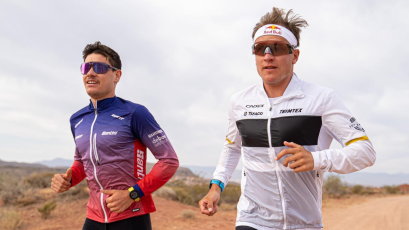
@mikaliden/ Gustav Iden y Kristian Blummenfelt
How to Train like a Norwegian – a Practical Approach for Age Group Triathletes
This year we have seen the emergence of Norwegian athletes dominating in running and triathlon. We have seen Jakob Ingebrigtsen winning gold in the 5000m at the world championships in Oregon. Gustav Iden and Kristian Blummenfelt have been leading the charge in triathlon with wins in Kona (IRONMAN) and St, George (IRONMAN 70.3) respectively.
Their success has been put down to the “Norwegian Method” of training known for lactate testing, controlled intensities, double session training days and high-volume training.
Marius Bakken recently published an in-depth article about the Norwegian training system, and I’ve taken this along with other articles, podcasts, videos, and research papers and extracted the key points so that athletes at all levels can use the techniques to train smarter.
First, we will look at how the Norwegians train with access to the best training locations and kit. Then we will look at how the principles can be applied to wherever you train and with the kit you have access to – a practical approach.
The Norwegian Training Method Key Elements
To give you a flavour of what this training looks like here’s Ingebrigtsens’ typical training and is well known and commonly shared:
- A strong focus on anaerobic threshold training and development
- Typical base week training of 2 x threshold morning and evening twice a week, hill work x 1 with a combination of slightly over 180 km of weekly volume (where the threshold work type varies from morning to evening – one with somewhat shorter and one with a bit longer intervals with a variation of intensity around the anaerobic threshold, see above)
- threshold training split into intervals instead of continuous sessions
- high altitude training winter and summer
- the threshold work in the lower range touching in to their anaerobic threshold
- Focused lactate meter-controlled sessions in winter and summer
For Kristian Blummenfelt the volume of training could look like this based on Strava data:
Monday
- Cycling 60km + Running 20km + Swimming 2km
Tuesday
- Running 10km + Swimming 2km
Wednesday
- Cycling 60km + Running 20km
Thursday
- Cycling 60km + Swimming 2km
Friday
- Cycling 60km + Running 20km + Swimming 2km
Saturday
- Running 10km + Swimming 2km
Sunday
- Cycling 60km
Based on Strava stats which also showed that most of his cycling sessions were outdoors. This is not exact but shows the volume of training he did in 2020.
This volume of training is yielding race swimming times at around 1:10 minutes per 100 meters over the course of an Ironman. They are riding their bikes close to 30 miles an hour, for the course of 112 miles. And then they're running off the bike in high heat in Hawaii a marathon in 2 hours, and 35 minutes.
But for time starved age group triathletes this training volume is impossible plus this is based on Ironman distances and you may be training for sprint, Olympic or half Iron distance races. They also focus on nutrition, hydration, sleep, recovery, and team collaboration for race success (we will cover this later).
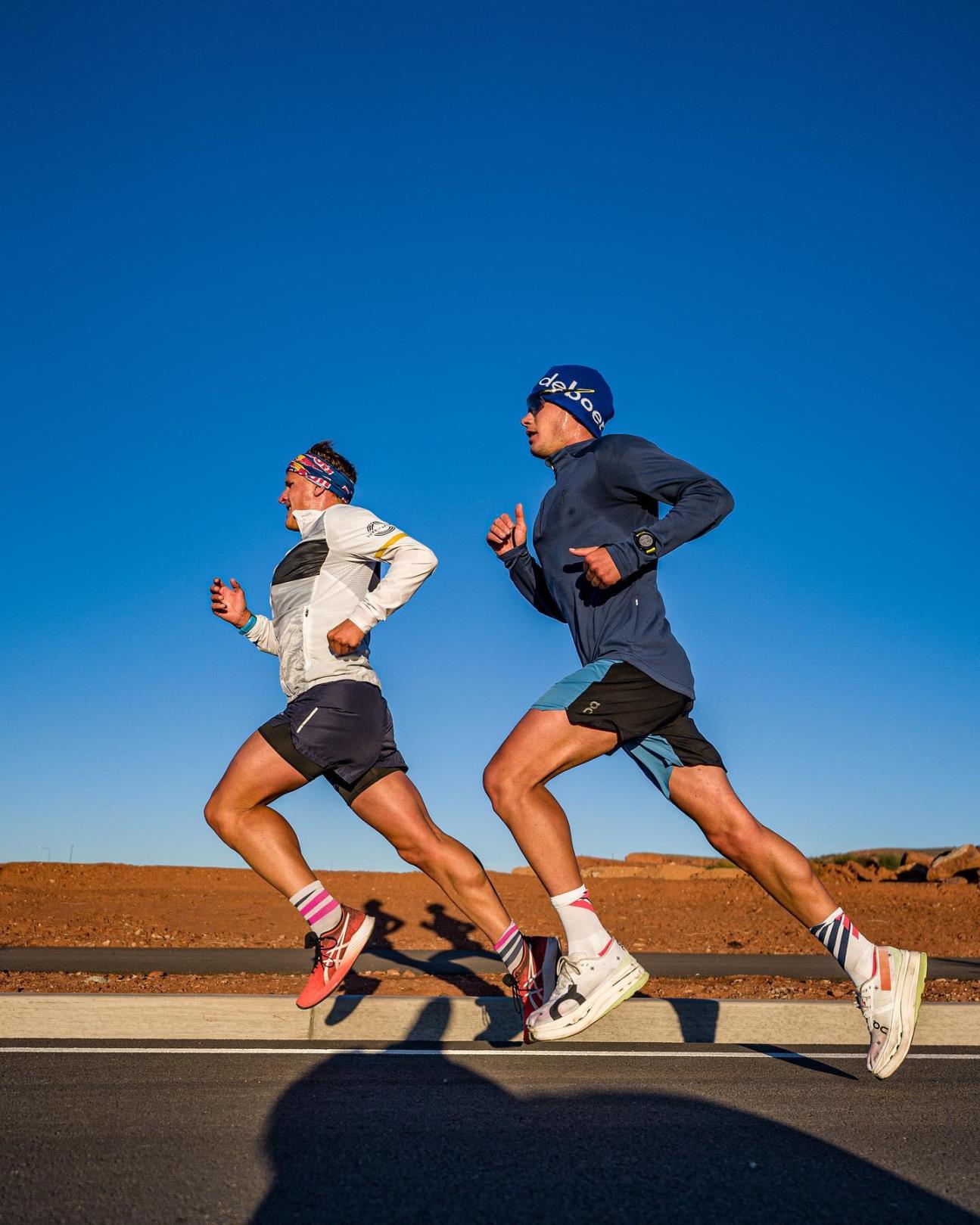
Sychronised flying! Gustav Iden and Kritstian Blummenfelt (Source: Facebook)
Lactate Testing
The Norwegians are famous for their lactate testing so they can ensure their athletes are training in the correct zones.
Lactate Threshold 1 (LT1) is the first point at which lactate starts to rise (from baseline levels). Lactate Threshold 2 (LT2) is the second point at which the lactate curve kicks up; this is the point at which the body can no longer keep up with (and clear) the amount of lactate that the muscle is producing.
The Norwegian training model has athletes controlling their intensity by monitoring their lactate levels, with a large portion of their running volume done at an easy pace (or zone 1). The majority of their interval training is done at an intensity that is just below their lactate threshold (zone 2), and a very small amount of their training is done at zone 3 (high intensity).
This is important because there are two factors that might cause you to slow down during a race or a hard effort:
- mechanical factors (your musculoskeletal, neuromuscular, and biomechanical systems)
- your aerobic system (your heart, lungs and cells).
For many athletes, their aerobic system tends to be the limiting factor between the two.
This is where your lactate threshold becomes important in training. Lactate is a by-product of glucose metabolism and energy production, and your body can re-cycle that lactate to be used to produce even more energy using a lactate-shuttling mechanism. When that mechanism is over-stressed, your lactate levels rise, you accumulate fatigue, and you must slow down. Raising your lactate threshold (the point at which lactate begins to accumulate) can produce significant performance benefits.
This is the reason why the Norwegians focus the majority of their interval work at that lactate threshold zone. They could go faster but they would be missing out on the aerobic benefits. Most age group athletes don’t have the tools to monitor their lactate threshold, but you can keep yourself within that zone 2 range during an interval workout by either paying for a lab based lactate test or doing a simple home test.
Running at this pace also allows you to do a much greater volume of intervals (if you have the base to do so), which will ultimately improve performance.
Below are examples of typical training sessions lactate threshold and sub-lactate.
Running
Run Workout #1
4x2km
4x1km
Staying in the Lactate threshold zone,
60 seconds recovery
Run Workout #2
3 x 10 sub-threshold then 4 x 5, 5 x 3 & 5 x 1 at threshold. Gustav Iden did this uphill at altitude in Sierra Nevada, Spain.
Swimming
In swimming they do high volume compared to most triathletes at 35,000 - 45,000m per week. A lot of this mileage is low intensity, but they do include sprints to have maximum speed practice. When they do threshold sets, they try to use longer intervals.
E.g., 3x1500m at the same intensity. They try to have longer periods of swimming constantly. They do speed work to practice for the start of the swim in competitions.
On camps they try to do around 6000-6500m swims, with at least one 7000m session per week and aim to swim around 6 times a week.
Cycling
In cycling they also have quite high volume, especially considering the athletes are ITU distance racers. The athletes are normally on the bike 5-6 times a week. When in Norway, it's not ideal to cycle outdoors so when they are home November-January they reduce cycling to 3 times a week. One will be an easy session and the rest are intervals. This could be up to 75 minutes of threshold sets. They have brick sessions indoors in the wintertime which last up to 4 hours.
During this they may do 40 minutes of bike intervals, then 8km running intervals, then 30-40 minutes on the bike, then 6-8km running intervals. They have found that if you mix threshold sessions in two disciplines you can have a higher threshold than just in one discipline. They normally do 1 brick session per week, but this increases closer to the race season. When they are on training camp, we have a higher volume of cycling. They will have at least one 4–5-hour session, and two or three 3-hour sessions. On training camps at altitude in Sierra Nevada, Spain (2300m high) every time we go out on the bike, they have at least 28km back home up to 2300m. They also do a lot of intervals on the hills.
During the threshold workouts they take a blood sample from the ear and measure the lactate level and adjust speed or power accordingly. During a run from Granada up to the top of Sierra Nevada (2,500, 28km) Kristian had his blood taken several times during the run to ensure his lactate levels were in the right range and adjusted the run using power adjustments on Stryd from 380 to 400 watts to keep in the lactate zone for the session.
They do full lactate lab testing every 6 weeks to keep tabs on improvements.
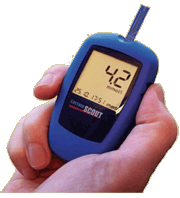
Blood Lactate Tester
Get your FREE Guide to Running Speed and Technique
Practical Approach to Training with LT1 and LT2
Most people don’t have a lactate tester, so you have a couple of options. When I was training in the UK my old University was offering lactate testing in the Sports lab for a reasonable price, so I underwent a very hard evening of testing and got my result based on a series of blood tests. Ideally you should do this for running, cycling, and swimming but if you had to choose one, I would complete the running test.
The alternative to work out you running threshold is:
Warm up with 5 mins in Z1, then 5 mins in Z2 then do 20 mins in the upper part of Z3 and finish with 5 mins in Z2 then 5 mins in Z1. Take your average pace for the 20 mins section and multiply by 0.95 to get an estimate of your current threshold.
For the bike if you can’t do a lab-based test then you can use Functional Threshold Power (FTP) which most triathletes are used to completing on Zwift, Wahoo etc. Your maximum effort for 1 hour is commonly the same as your lactate threshold. Dr. Andy Coggan realized this, so he came up with the FTP concept and simplified things for everyone.
If you don’t have a power meter you can do a Heart Rate based similar test. Details of these test can be found in this Blog.
Of course, these methods will only give you either data valid on that day or an approximation of your lactate threshold. But you can do these tests periodically to reset your targets for each session.
It’s not going to be blood, sweat and tears – but no blood, plenty of sweat and hopefully no tears!
Double Lactate Sessions
According to Bakken’s paper, one of the biggest differences between the Norwegian training model and other training models is the inclusion of days when the athlete does not one, but two threshold workouts. Of course, the concept of doubling (especially for triathletes with Brick sessions for example) is not new. In fact, it is a very commonplace practice for most elite runners. In most cases, though, the athlete will do one workout and one recovery run in the same day, not two hard workouts.
Doing two hard sessions a day may sound daunting, but these are not all out maximum effort sessions but two threshold sessions.
When these workouts are run at the correct intensity you won’t feel too fatigued so you could theoretically do another threshold session a few hours later. This allows the Norwegians to do a greater volume of work than they could if they tried to do one big session.
But for age group athletes time may not allow for two threshold sessions a day so one good quality threshold session should be enough to gain the adaptations you need.
Low Intensity Endurance Sessions - Polarised versus Pyramidal Training
In the Norwegian modal a large portion of their running volume is done at and easy pace (zone 1) and interval training is done at just below lactate threshold (Zone 2) and a small amount of high intensity in Zone 3.
This is good news for age group triathletes as doing the majority of your sessions in Zone 1 will help prevent injuries. But you must be disciplined in this regard and not venture to much out of Zones 1 or 2.
Practically speaking if you have a plan that has 80% of your training at lower intensity and 20% for example, at high intensity you could adapt this to 80% in Zone 1 and 20% or less at Threshold.
In an episode of the Physical Performance Show, Bu said that this shift resulted in a change to the programming model for Blummenfelt and his training partners: “From the Olympics, where it was more or less threshold-oriented, it has maybe become more base or pyramidal-oriented…as you go down in intensity, you get more and more volume.” He also noted that while a training week can be polarized, this is not the pattern that the team typically follows.
The concept of training intensity distribution (TID) is defined as the amount of time that the athlete spends in different zones of training intensity during exercise. Usually, TID is calculated by using three training zones: zone 1 (Z1), below the first threshold; zone 2 (Z2), between the first and the second threshold; zone 3 (Z3), above the second threshold. The intensity distribution known as polarized training is defined as having the highest percentage of time spent in Z1, a smaller, but relatively high percentage in Z3, and only a small portion of training in Z2 (i.e., Z1 > Z3 > Z2). On the other hand, pyramidal TID is characterized by accumulating a higher percentage of training time in Z2 and less in Z3, but, as in the case of the polarized model, the highest percentage of training is spent in Z1 (i.e., Z1 > Z2 > Z3).
Several experimental studies have shown the potential benefits of both polarized and pyramidal TID compared to other TID models for endurance sports. A recent review on this topic showed that these two models appear to be the most effective for boosting endurance performance in middle‐ and long‐distance runners.
In practical terms you can find both polarised and pyramidal style plans on platforms like TrainingPeaks and Final Surge so you can choose which type of training will suit you best and the time you have to train. A professional athlete has the "luxury" of lots of time to train so pyramidal can work for them. For a busy time crunched triathlete a polarised 80/20 style plan may be easier to fit into a working week.
You could also deploy either approach situationally. If for example you missed the podium in a race because you got beat during the mad sprint to the finish, perhaps a polarized approach with a bit more time spent in zone three would be beneficial. Or if you posted a couple of DNFs in longer events, then perhaps your baseline endurance and moderate intensity output maybe lacking, and could benefit from going back to the zone one, two, and three spread of pyramidal training.
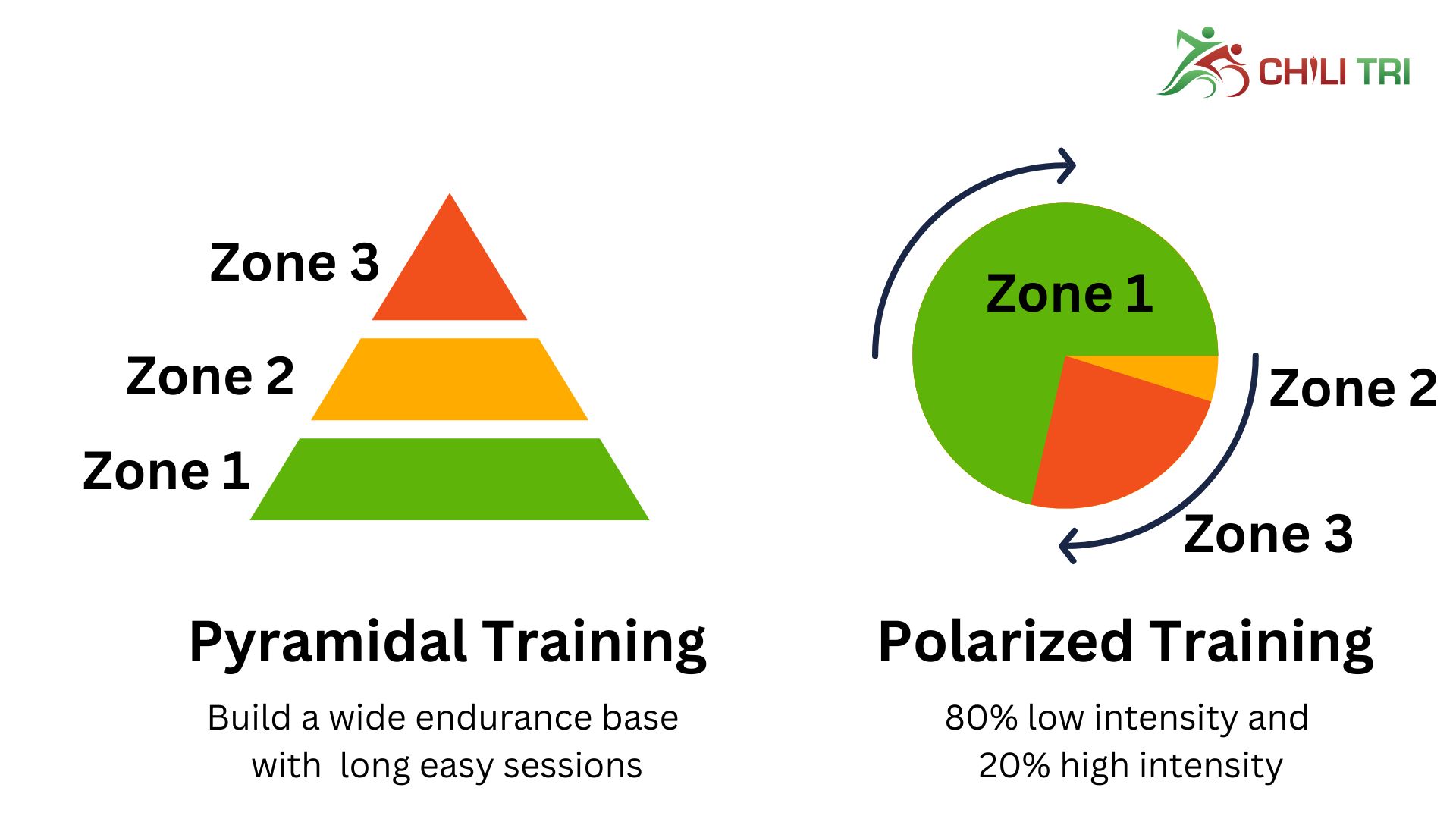
Breath and Core Temperature Testing
Three things Ole Aleksander Bu (Kristian’s coach) points out as essential for his massive success are calorimetry and indirect calorimetry, the Moxy Oxygen Monitor and aerodynamics.
Calorimetry: The measurement of energy consumption in humans, where we distinguish between direct and indirect calorimetry. In direct calorimetry, energy consumption is calculated by measuring the heat the person emits, while in indirect calorimetry, energy consumption is calculated by measuring the amount of oxygen consumed and the amount of carbon dioxide produced – especially during training. The measurements tell how much protein, fat and carbohydrates have been used as an energy source, and thus how high the energy consumption has been.
Moxy: An oxygen monitor that measures and provides insight into oxygen levels in muscles. The oxygen level in muscles can change based on altitude and climate. Moxy kits start from €749.
Core Temperature: The Norwegians changed from a suppository sensor to a non-invasive sensor from CORE which you could use either on a chest or arm strap €259 per sensor. I will leave it up to you if you think this is important for your training.
When exercising your core body temperature rises and as this rises, your performance (power) goes down. Monitoring your core body temperature will give you the knowledge and insights to improve your performance
Aerodynamics: The study of the movement of air and the forces bodies are exposed to when they move through air or when air flows around them.
Alongside the Supersapiens sensor, moxy sensor and core temperature sensor Kristian also wears a heart rate monitor and Styd running footpod. You can use my code: coachparnell to get 15% off a Stryd footpod.
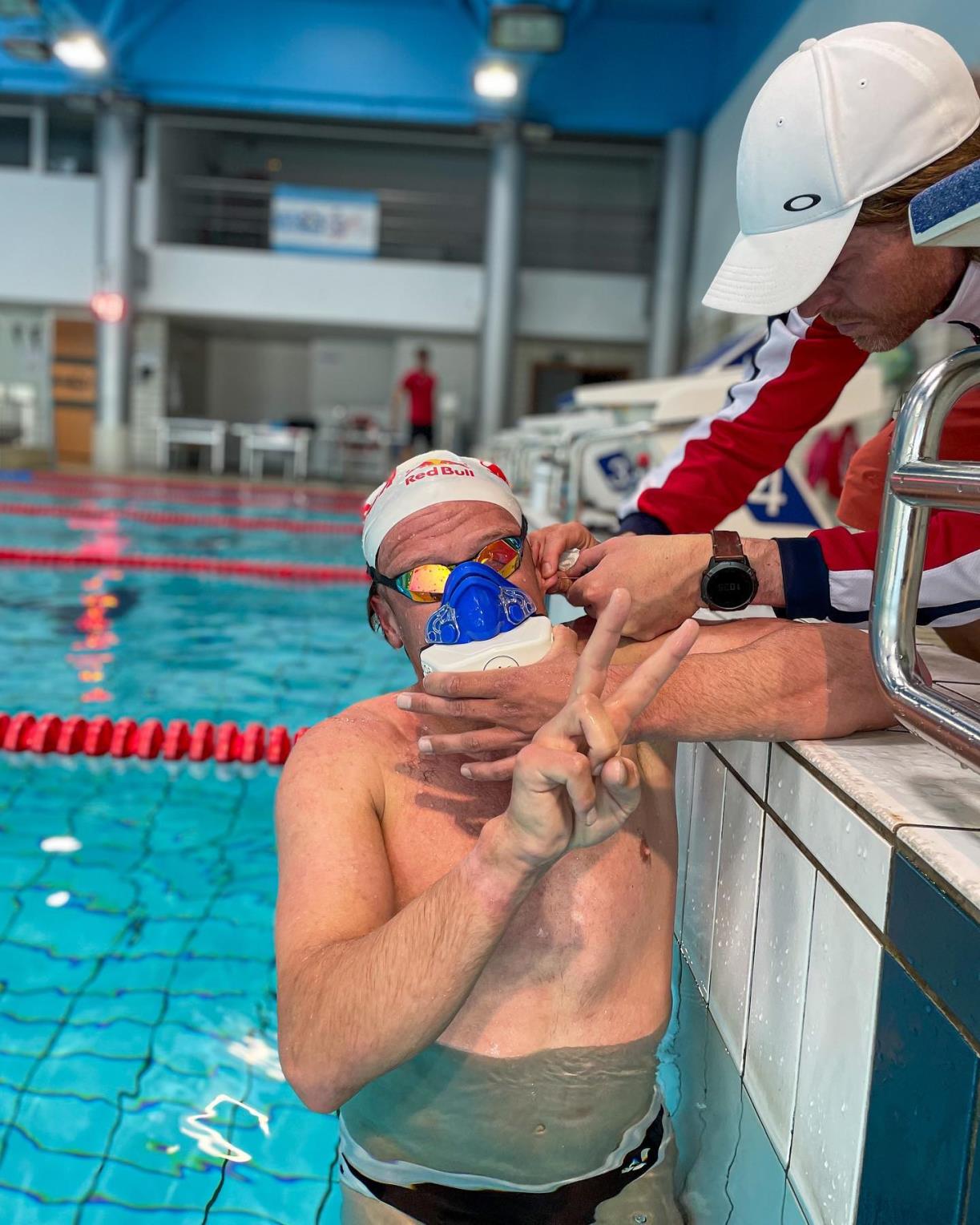
Kristian Blummenfelt at the Sierra Nevada High Altitude Centre (Source: Facebook)
Get your FREE Swim Workouts for Triathletes E-book
Practical Approach to Sensors and Technology
I would not suggest running out and buying a core temperature checker or oxygen analysis mask, but you could ensure you are eating a healthy diet and eating enough to sustain your training regime. An easy first step is to calculate your Basal Metabolic Rate (BMR) and from there your calorific needs for your training levels. You can read more about how to calculate your BMR here.
For bike aerodynamics the best bang for your buck is on the bike as you will spend the most time on it during a race. Make sure you get a good bike fit and can sustain a comfortable aerodynamic position during training which you can use on race day.
Top Tip from Gustav: “Buy a TT suit and wear it on the turbo when cycling as it will keep you in the aero position as it is uncomfortable if you sit up!”. This is after he spent 5 hours continuous on Zwift on a training camp in Sierra Nevada.
For the swim you need to develop a good hydrodynamic stroke which will give the least amount of water resistance. Getting a swimming video analysis of your stroke above and below the water is a good idea so you can see where you can optimise your stroke and body position in the water.
Kristian and Gustav both use FORM goggles as part of their training regime. Some of my plans on TrainingPeaks and Final Surge have FORM goggle training sessions which you can load onto your FORM goggles and swim along with them using the goggle display.
You can purchase FORM goggles here on Amazon.
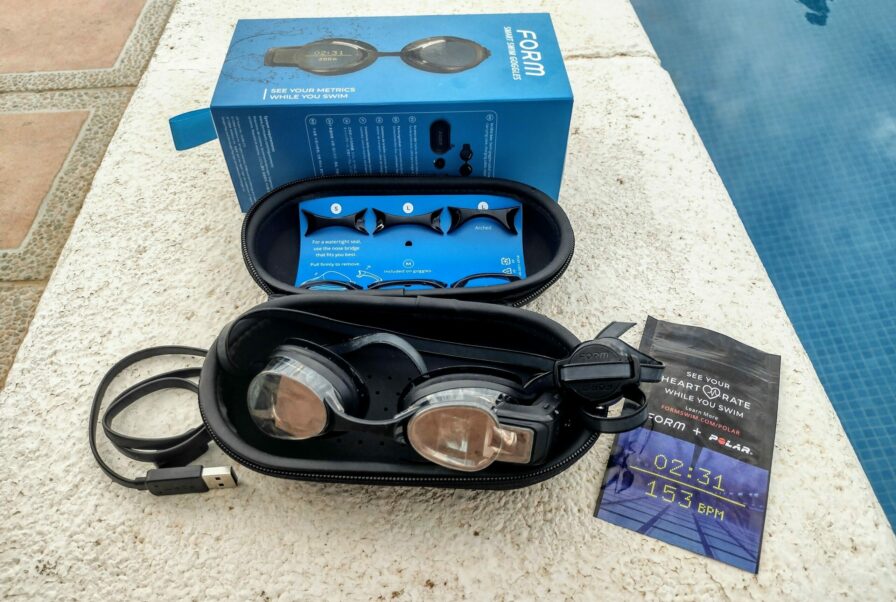
FORM Goggles being use at Chilitri
Get your FREE Swim Workouts for Triathletes E-book
For running you could emulate Kristian and get a Stryd running footpod so you can analysis your running cadence, power and more to start improving your ground contact time and running efficiency. I’m a Stryd running with power coach and can offer you 15% off with my code: coachparnell.
Some of my training plans on Final Surge and TrainingPeaks have Stryd workouts included.
High Altitude Training
This year the Norwegian team spent six weeks at my local high-altitude centre in the Sierra Nevada mountains in Southern Spain. It was built to support the Barcelona Olympics in 1992. It’s a very cost-effective place to do high altitude training and available to any athlete – professional or amateur. It has a 400m outdoor track, 50m swimming pools, gyms, accommodation, and everything needed to train well.
Bakken pointed out that some runners have lived at altitude for large parts of their life. For those runners, it seems like one can get away with less total load of threshold work to get close to the maximum ability. Maybe this is why the Norwegians spend many weeks a year training at altitude to replicate this?
On high altitude training camps their daily cycles tend to be:
1st day: 2 interval sessions
2nd day: long, low intensity
3rd day: 2 interval sessions
4th day: half rest day
This cycle tends is different from the cycles they employ when at home which can be 7 or 8 days in cycle length.
High Altitude Training Camps are great experience for age group athletes to experience the high-performance athlete lifestyle, but an extended stay will give you the most benefit just before a race and this can be hard to fit into a busy schedule. If you are interested in a high-altitude training camp experience, then get in touch and I can discuss how this works.
Video of Kristian Blummenfelt running up a mountain in the Sierra Nevada on his YouTube channel
Get your FREE Sprint Triathlon Training Plan
Strength & Conditioning
Building strong muscles, bones, ligament, and tendons is a must for all triathletes and as we age this gets more and more crucial.
Kristian likes to integrate trail running into his weekly running to build strength, stability, and mobility – this is again something you can easily do. He also does an extended warm up before swimming with band, press-ups and more. Back in 2019 he started concentrating on using weights to strengthen his swim muscles to increase his swim power and maintain good technique for longer by lifting heavy with lower reps. The Norwegian team are also using strength training to remain injury free and depending on the athletes needs they focus on upper body or lower body.
Kristian Blummenfelt discusses the Norwegian strength training on Mikel Iden YouTube channel
Get your FREE 23-Page Athletes Guide to Strength and Conditioning
For age group triathletes is extremely important to include strength session regularly to increase power and speed but most importantly to decrease the risk of injury. For older athletes it’s important to reduce the effect of sarcopenia and you can read more about this here.
I have strength and conditioning plans on Final Surge and TrainingPeaks to help you structure your strength sessions.
I also have Trail running plans should you want to add this to your training in the off-season to maintain strength.
Nutrition, Hydration & Diet
The Norwegians eat after each training session to ensure they have the right nutrients for their muscles to repair and rebuild stronger. This is probably high in good quality protein so their muscles can “eat” well. They also hydrate well and eat during the training sessions and are well known for using Maurten products. You can get them on Amazon.
This is easy for you to emulate and aim to take on a protein rich meal within 20 minutes of your training. Sometimes this can be hard to find or prepare so good quality protein shakes can be used occasionally but make sure they are on the batch tested UKAD list.
Drinking enough electrolytes and water is also key.
If you watch the day in the training life of Kristian, you will see he starts the day with a triple expresso – this is one you could replicate easily! Interestingly Gustav Iden likes to take his morning caffeine in the form of a gel with added caffeine.
Get your FREE Athlete Recipe Books
Sweat Testing
Sweat testing is a good way to assess your electrolyte, salt, and water needs. You can use a testing kit from for example Bestziet or you can complete a very simple home sweat test. You can read about how in this blog on sweat testing.
Sleep & Recovery
The Norwegians take recovery very seriously and they take a nap of around 60 minutes every day! They also make sure they get at 10-12 hours of good quality sleep a day.
Again, this is something you can add to your training easily and experiment with daily naps and employ good sleep hygiene. Most good sports watches will help you track this, for example those from Garmin and Polar. You should be aiming for at least 8 hours of good quality sleep a night. Read more about the secrets to good recovery.
Heart Rate Variability (HRV)
The Norwegians monitor HRV to manage training load through measuring stress levels – physical and mental.
For age group athletes stress comes in many forms – work, money, travel, training and more. Tracking your stress levels can inform how hard you should train every day. Using a heart rate monitor and simple App like the Elite HRV you can take your stress levels every morning. You will see your sympathetic (fight or flight) and parasympathetic (rest and digest) nervous system and from this you can workout your stressors and how your body is reacting. This is good to enable you to avoid over training and you can read more here.
Coaching & Mentoring
Without doubt the Norwegians have a great team around them and all the technology but underneath this is a collaborative coaching approach where education is key. The team discuss the what they are doing, the how and the why. They work together as a team towards a common goal and develop a training plan that works for everyone and adapts over time based on what they have collectively learnt and of course the copious amounts of test data.
The team say that the key to good training is to stay motivated and be patient for the training methods to take effect. For example, Kristian’s overnight success was ten years in the making!
For you as an athlete planning is key so whether you engage a coach, a mentor, or get a professionally written training plan this will help add structure and focus to your training. A coach will also help you with accountability and be your mentor when times get tough. They can also adjust your sessions around your work and life changes.
Conclusion - How to Train Like a Norwegian as an Age Group Athlete
We can learn a lot from the Norwegians and can implement much of what they do. You should first start with the basics such as good health habits, nutritious food, hydration, sleep (maybe even daily naps?) and a structured plan.
From there you can add in more science-based testing and feedback if this works for you like HRV to help with stress and sleep, Supersapiens for carbohydrate requirements, Bestziet for sweating testing and even a full lactate testing analysis.
Triathlon is an aerobic sport. The practical implications of this are applied by the Norwegian team: big volume at low intensity and longer intervals during the hard work sessions. Practically this can be achieved by completing the low intensity sessions in your current training plan in Z1 and the high intensity sessions at Lactate Threshold 2. But always remembering that your training journey should be fun and the racing should be the icing on the cake!
Karen Parnell is a Level 3 British Triathlon and IRONMAN Certified Coach, 8020 Endurance Certified Coach, WOWSA Level 3 open water swimming coach and NASM Personal Trainer and Sports Technology Writer.
Karen is currently studying for an MSc in Sports Performance Coaching at the University of Stirling.
Need a training plan? I have plans on TrainingPeaks and FinalSurge:
I also coach a very small number of athletes one to one for all triathlon and multi-sport distances, open water swimming events and running races, email me for details and availability. Karen.parnell@chilitri.com
Get your FREE Guide to Running Speed and Technique
Get your FREE Swim Workouts for Triathletes E-book
Get your FREE Open Water Swimming Sessions E-Book
Get you FREE 31 Structured Indoor Cycling Sessions and Training Plan
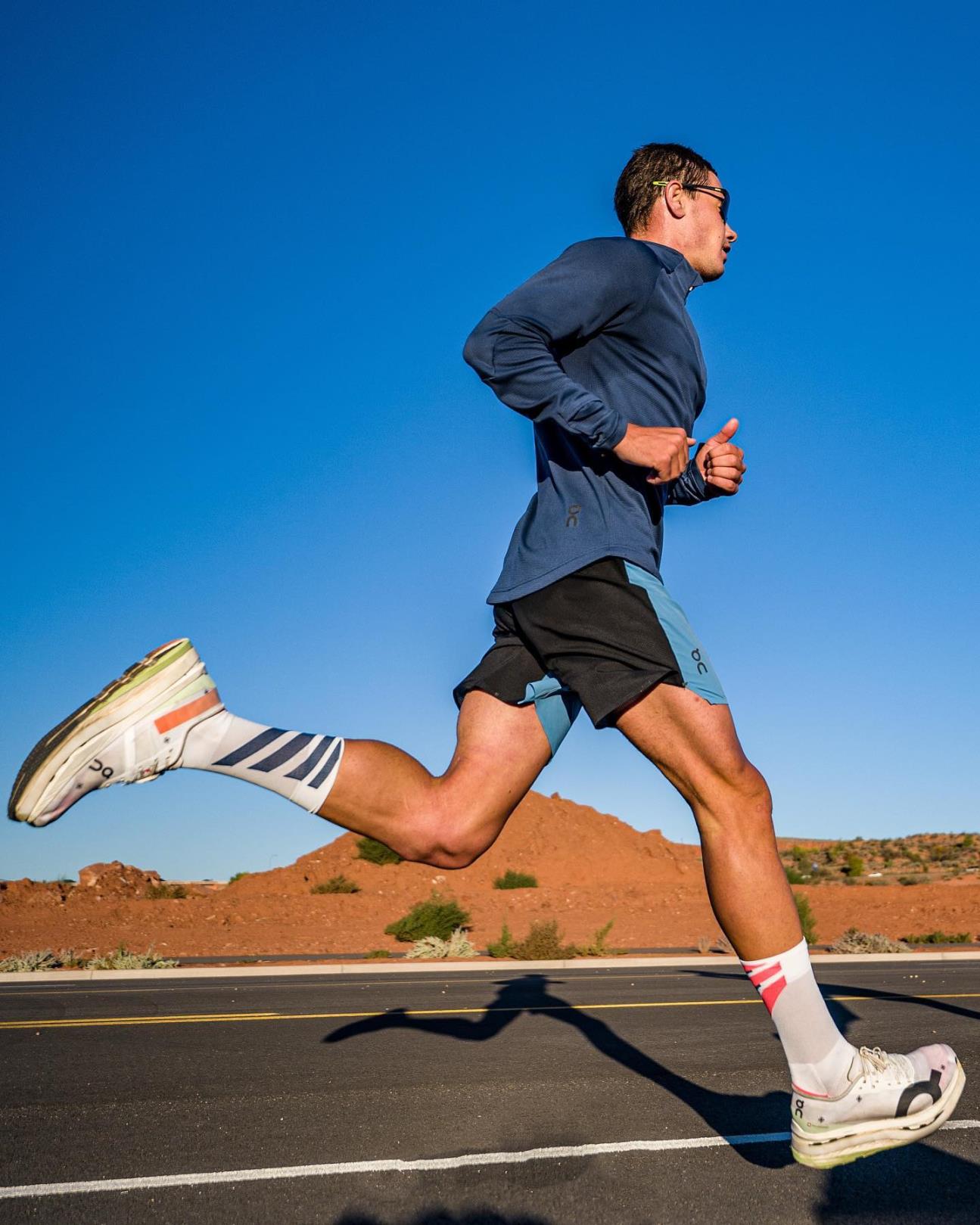
Gustav Iden and his famous On running shoes Source: Facebook
References
www.mariusbakken.com/the-norwegian-model.html
https://prosworkout.com/kristian-blummenfelt/
We Put the Norwegian Training Methods to the Test – Triathlete
Kristian Blummenfelt: Inside his Kona Ironman training (redbull.com)
How to train like a Norwegian - Triathlon Magazine Canada
https://scientifictriathlon.com/tts154/
How the Norwegian Training Method Powers World Champion Triathletes (trainingpeaks.com)
Polarized vs. Pyramidal Training — Which is Better For Your Athletes? (trainingpeaks.com)
Norwegian Glossary
Acidosis: The production of acid in the body
HRV: A measure of the variation in time between each heartbeat, which offers an insight into the body’s autonomic nervous system. In general, if the system is in more of a “fight or flight” mode, the variation between heartbeats tends to be lower. If the system is more relaxed, the variation between beats may be higher.
Lactate test: A test designed to measure lactate levels, usually ramping in intensity
Lactate Threshold 1 (LT1): The first point at which lactate starts to rise (from baseline levels)
Lactate Threshold 2 (LT2): The second point at which the lactate curve kicks up; this is the point at which the body can no longer keep up with (and clear) the amount of lactate that the muscle is producing
Morning Readiness: An indicator of the body’s ability to perform, based on HRV and RHR data e.g., if HRV is lower than normal and RHR is higher it might be prudent to scale back training intensity
Mmol/L: Millimoles per liter, the unit of measurement for lactate acid in the blood
MHR: Maximum heart rate, the maximum number of times your heart can beat in one minute
RHR: Resting heart rate is your heart rate taken first thing in the morning upon waking and is a good indicator of fatigue
TSS: Training Stress Score, a score used by the TrainingPeaks platform to indicate the estimated physiological stress and load created by a training session (based on duration and intensity)
FAQ: The Norwegian Training Method for Athletes
What is the Norwegian method of training?
The Norwegian method, also known as the Norwegian training model, refers to a training approach commonly used in endurance sports, particularly in cross-country skiing and distance running. It emphasizes high training volumes, long-term development, and a focus on building a strong aerobic base.
What are the key principles of the Norwegian method?
The Norwegian method incorporates several key principles, including:
- High training volume: Training involves significant time and mileage dedicated to endurance workouts.
- Emphasis on aerobic base: The method prioritizes developing a strong aerobic capacity through long, slow-distance training.
- Year-round training: It promotes consistent training throughout the year, with gradual progressions and planned training cycles.
- Holistic approach: The method emphasizes the importance of overall health, including adequate rest, recovery, nutrition, and strength training.
- Long-term development: The Norwegian method focuses on gradual improvement and long-term athlete development rather than short-term gains.
Who is the Norwegian method suitable for?
The Norwegian method can be suitable for athletes involved in endurance sports such as distance running, cross-country skiing, cycling, or triathlon. It is commonly used by athletes at various levels, from recreational to elite, who aim to improve their aerobic capacity and overall endurance performance.
What are the benefits of training using the Norwegian method?
Training with the Norwegian method offers several potential benefits, including:
- Enhanced aerobic capacity: The focus on building a strong aerobic base can lead to improved endurance and stamina.
- Increased efficiency: High training volumes can help improve efficiency in movement patterns and biomechanics.
- Improved recovery: The emphasis on adequate rest and recovery helps prevent overtraining and reduces the risk of injury.
- Long-term progress: The method's focus on gradual development contributes to sustained improvements over time.
- Transferability to other sports: The principles of the Norwegian method can be applied to various endurance sports, making it versatile for athletes in different disciplines.
How do I implement the Norwegian method in my training?
Implementing the Norwegian method in training requires careful planning and a long-term approach. Consider the following:
- Gradual progression: Start with lower training volumes and gradually increase mileage over time to avoid injury and overtraining.
- Focus on aerobic training: Incorporate regular long, slow-distance workouts to build an aerobic base.
- Training cycles: Divide your training into cycles that include periods of higher intensity and lower intensity to promote adaptation and recovery.
- Rest and recovery: Prioritize adequate rest days and recovery periods to allow your body to adapt and avoid burnout.
- Seek professional guidance: Consulting with a coach or experienced trainer familiar with the Norwegian method can help you create a tailored training plan and provide guidance along the way.
Are there any potential drawbacks or considerations for the Norwegian method?
While the Norwegian method can be effective, it's important to consider individual needs, limitations, and goals. Some potential considerations include:
- Time commitment: The method typically requires a significant time commitment due to the emphasis on high training volumes.
- Individual differences: Not all athletes respond the same way to training methods, so it's important to assess personal strengths, weaknesses, and adapt the training accordingly.
- Injury risk: The high training volumes and repetitive nature of endurance training can increase the risk of overuse injuries. Proper rest, recovery, and monitoring are essential to mitigate this risk.
Remember that individual responses to training methods can vary, and it's crucial to listen to your body, monitor progress, and make adjustments as needed. Consulting with a qualified coach or sports professional can provide valuable guidance tailored to your specific needs.
#triathlon #trainlikeanorwegian #triathlontraining #ironman #hr #heartrate #power #pace #runtraining #traithlontrainingplans #runningtrainingplans #swimmingtrainingplans
